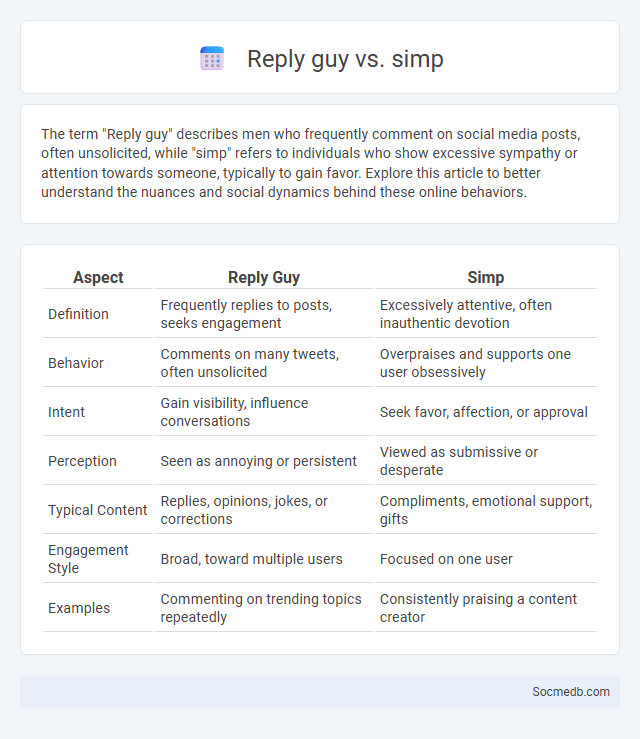
Photo illustration: Reply guy vs simp
The term "Reply guy" describes men who frequently comment on social media posts, often unsolicited, while "simp" refers to individuals who show excessive sympathy or attention towards someone, typically to gain favor. Explore this article to better understand the nuances and social dynamics behind these online behaviors.
Table of Comparison
| Aspect | Reply Guy | Simp |
|---|---|---|
| Definition | Frequently replies to posts, seeks engagement | Excessively attentive, often inauthentic devotion |
| Behavior | Comments on many tweets, often unsolicited | Overpraises and supports one user obsessively |
| Intent | Gain visibility, influence conversations | Seek favor, affection, or approval |
| Perception | Seen as annoying or persistent | Viewed as submissive or desperate |
| Typical Content | Replies, opinions, jokes, or corrections | Compliments, emotional support, gifts |
| Engagement Style | Broad, toward multiple users | Focused on one user |
| Examples | Commenting on trending topics repeatedly | Consistently praising a content creator |
Understanding the Terms: Reply Guy vs Simp
The term "Reply Guy" refers to individuals who frequently respond to social media posts, often offering unsolicited opinions or attempting to gain attention, while a "Simp" describes someone who excessively flatters or supports another person, typically in hopes of receiving affection or approval. Understanding these distinctions helps you navigate online interactions with greater awareness and avoid common social media pitfalls. Recognizing these behaviors can also improve your engagement strategy by fostering genuine connections instead of superficial approval-seeking.
Origins of “Reply Guy” and “Simp”
The terms "Reply Guy" and "Simp" originated within online communities and social media platforms like Twitter and TikTok, reflecting evolving digital interaction dynamics. "Reply Guy" emerged as a label for men who frequently comment unsolicited responses to women's posts, often aiming for attention or validation. "Simp" gained popularity as a term describing individuals, typically men, who show excessive deference or affection toward someone, often with the hope of winning romantic interest, highlighting shifting definitions of online social behavior.
Behavioral Traits: Comparing Reply Guy and Simp
Reply Guys often exhibit persistent commenting behavior characterized by excessive replies to a specific user's posts, showcasing traits of assertiveness and a desire for visibility. Simps demonstrate a pattern of overvaluing and excessively praising content creators, driven by admiration and a strong emotional investment, sometimes leading to skewed social interactions. Understanding these distinct behavioral traits can help you navigate social media dynamics more effectively and manage interactions with these archetypes.
Social Media Dynamics: How Reply Guys and Simps Operate
Social media dynamics reveal distinct behaviors where Reply Guys frequently engage by persistently commenting on posts, seeking attention or validation from influencers. Simps often demonstrate excessive admiration or support, often to gain favor or recognition on platforms like Twitter or Instagram. Understanding these patterns can help You navigate interactions more strategically and maintain authentic online relationships.
Motivations Behind the Behavior
Understanding your motivations behind social media behavior reveals the desire for social connection, self-expression, and information seeking. Users often engage to build relationships, gain validation, or stay informed about trends and news. These psychological drivers shape the frequency, content, and platforms chosen, influencing overall online interaction patterns.
Public Perception and Stereotypes
Public perception of social media often revolves around concerns of privacy invasion, misinformation, and negative impacts on mental health. Stereotypes about social media users include assumptions of superficiality, addiction, and reduced face-to-face communication skills. These perceptions shape both user behavior and regulatory approaches to online platforms.
The Impact on Online Conversations
Social media platforms have transformed online conversations by enabling real-time interactions and diverse viewpoints across the globe. Your engagement shapes digital discourse, influencing trends and the spread of information. Algorithms amplify content visibility, directly impacting how dialogues evolve and develop in virtual communities.
Gender Dynamics and Power Structures
Social media platforms amplify gender dynamics by both challenging and reinforcing traditional power structures through user interactions, content creation, and algorithmic biases. Studies reveal that women and non-binary individuals often face disproportionate harassment, limiting their visibility and influence online while men dominate discourse in high-profile digital spaces. Analyzing these platforms through intersectional lenses highlights the need for policies addressing systemic inequalities embedded in social media ecosystems.
Dealing With Reply Guys and Simps Online
Dealing with reply guys and simps online requires clear boundary-setting and selective engagement to maintain a positive social media experience. Employing privacy settings and muting or blocking tools on platforms like Twitter and Instagram helps minimize unwanted interactions and control one's digital space. Recognizing patterns in behavior enables users to respond assertively while protecting mental well-being from persistent or intrusive comments.
Redefining Digital Interactions and Boundaries
Social media platforms are redefining digital interactions by creating new spaces where personal and professional boundaries blur, reshaping how You communicate and build relationships online. The integration of immersive technologies like augmented reality and AI-driven content curation enhances user engagement while raising critical concerns about privacy and digital well-being. These evolving dynamics challenge traditional concepts of identity and connection, prompting a reevaluation of online behavior and social norms.
 socmedb.com
socmedb.com